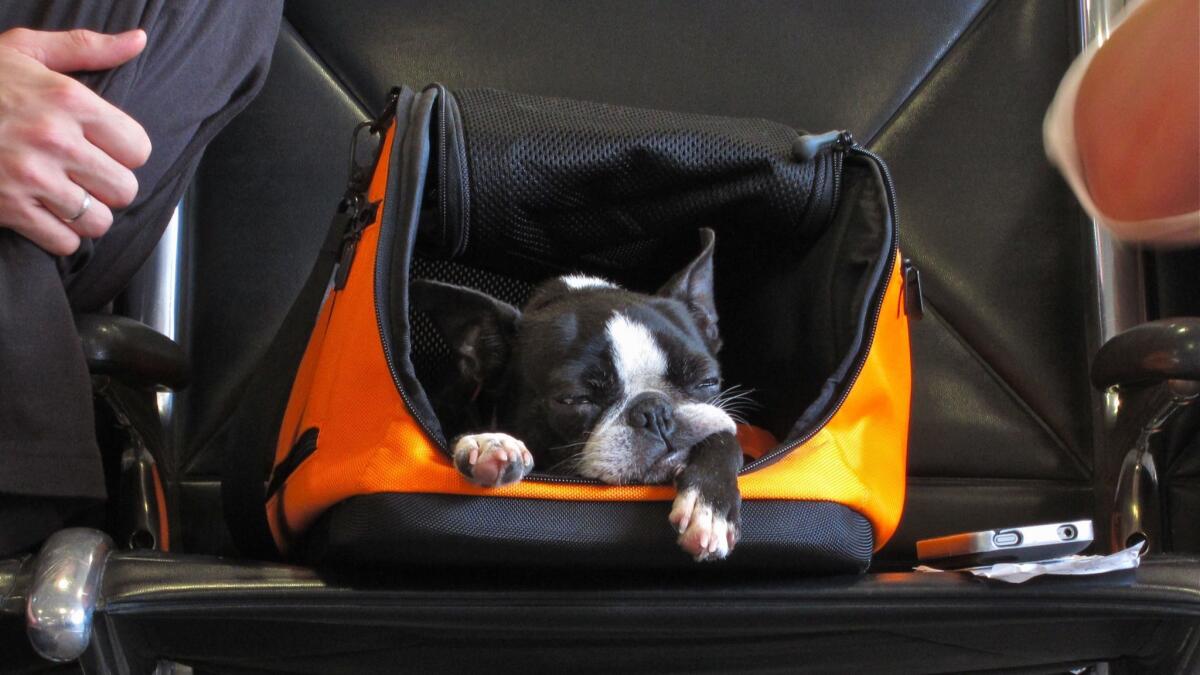What you need to know about flying with service and emotional support animals

The uproar over emotional support animals in aircraft cabins took wing again with the recent rejection of a peacock as a proper companion. But if a person needs that animal, what’s the big deal?
It becomes apparent after reading the regulations in the Americans With Disabilities Act and the Air Carrier Access Act governing such animals, and it becomes even more apparent with expert input.
Here’s what you need to consider as a traveler. There is no clear-cut answer, but it has less to do with your thoughts about animals and more to do with conflicting regulations. So to begin:
--There’s an important difference between service animals and emotional support animals, said Sandra Barker, director of the Center for Human-Animal Interaction at Virginia Commonwealth University and a professor of psychiatry at VCU’s School of Medicine.
“Emotional support animals are not required to be trained, which opens a lot of questions and concerns about public safety,” she said.
Recent incidents include a dog that bit its owner’s seatmate on a Delta flight and a child who was slightly injured by a dog during the boarding of a Southwest flight.
This is not to say that all emotional support dogs or animals are badly behaved. Nor is it to say that all service animals are perfect, but they are trained to focus on their job, not on distractions.
Service animals also are evaluated for temperament before they undergo training, Barker said.
“If something startles [a service animal], it’s OK to be startled,” Barker said. “But if a wheelchair falls over [and there is] a sign of aggression, that is a clear indicator [of] not being an appropriate” candidate for the role.
Owners of service animals also undergo training to enable them to make the most effective use of their animal, said Catherine Salmon, a psychology professor and faculty member in the human-animal studies program at the University of Redlands.
--Regulations don’t always agree. The Air Carrier Access Act, which says it prohibits “discrimination on the basis of disability in air travel,” does not differentiate between service animals and emotional support animals.
Such an animal is one “that is individually trained or able to provide assistance to a person with a disability; or any animal that assists persons with disabilities by providing emotional support.”
But the Americans With Disabilities Act, the 1990 law that describes itself as a “civil rights law that prohibits discrimination against individuals with disabilities in all areas of public life,” recognizes only dogs and miniature horses (which were added later) as service animals and notes that animals “whose sole function is to provide comfort or emotional support do not qualify as service animals under the ADA.
“Service animals,” it goes on to say, “are working animals, not pets.”
--The less exclusive Air Carrier Access Act may have unwittingly given rise to an increasing number of emotional support animals on airplanes.
United, for instance, flew 77,000 of them in 2017, a 77% increase from the previous year, the Chicago Tribune quoted a United rep as saying.
A more lenient definition is not a bad thing unless...
--The traveler who is flying with an emotional support animal is gaming the system.
Does it happen? I don’t have statistics to prove this because, really, who’s going to say, “Of course, I’m cheating”?
Absent that, we can be sure that some people claim emotional support status for their animal because they worry about it flying in the belly of the plane. Some don’t want to pay the fee to fly a pet in the cabin. (Emotional support animals usually fly for free.) And some just like their pet so much they don’t want to be separated from the little darling.
Anyone can outfit their pet with an emotional support animal vest, as an ABC News piece showed, but that doesn’t mean it’s true anymore than wearing a stethoscope around your neck makes you a doctor.
With the flimsiest of evidence, ABC managed to get two dogs and a hedgehog onto flights, although the hedgehog was rejected on a first attempt.
And so...
--United and Delta have strengthened regulations governing emotional support animals.
As of March 1, United has changed its requirements for the animals. “In addition to providing a letter from a licensed medical/mental health professional, customers will need to provide a veterinary health form documenting the health and vaccination records for the animal as well as confirming that the animal has been trained to behave properly in a public setting.”
Delta’s requirements are much the same. Both airlines ask that the paperwork be submitted at least 48 hours in advance.
Where does this leave us? In a quandary. Barker and Salmon, interviewed separately, hold slightly different opinions. Both agree that animals can provide tremendous benefits to their owners, and studies support that.
Barker, however, would recommend treating the underlying disorder rather than relying solely on an emotional support animal. She has been asked to write a letter as a health professional in support of the need for such an animal, and “I have not felt comfortable doing so,” she said, adding, “I don’t know the animal’s temperament or background.”
Salmon is a bit more lenient about letting emotional support animals fly, but hopes that people who want their pet in flight will “pay and put them under the seat.”
What do you think? Should regulations be toughened? How would you address this continuing conundrum? Write to us. Please include your name and city of residence.
Have a travel question or dilemma? Write to travel@latimes.com. We regret we cannot respond to every inquiry.
More to Read
Sign up for The Wild
We’ll help you find the best places to hike, bike and run, as well as the perfect silent spots for meditation and yoga.
You may occasionally receive promotional content from the Los Angeles Times.







